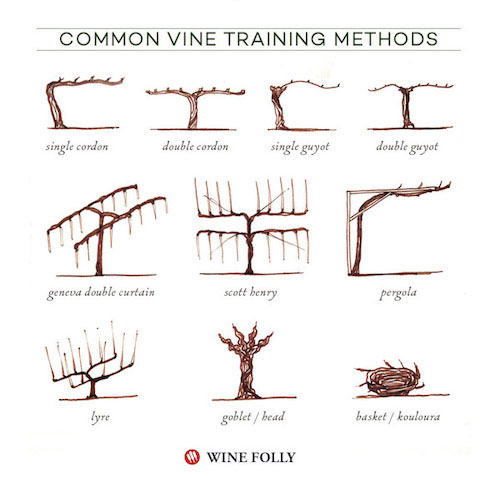GRAPE
PRUNING
Cane pruning (guyot).
Is commonly used in cooler climate growing regions, including Burgundy, Sonoma, and Oregon.
By limiting the vine’s lignified growth (the hard brown part) to just the trunk, the vine is less vulnerable to frost and better protected than spur pruned vines.
Spur pruning (cordon).
Is common to see in warmer climate growing regions, including California, Washington, and Spain. Spurs (the stub of a cane that contains 1-3 buds) are generally easier to prune and certain training systems, such as goblet method, are ideal for areas prone to drought. Spur pruning is a more traditional training method that is known to produce outstanding old vine wines.
High Vines: Tall vine trunks lift the grapes higher above the ground to increase airflow and increase sun exposure, which reduces the probability of fungal infections. This training method is more common in cooler climates with high moisture.
LOW Vines: Short vine trunks reduce a vine’s exposure to the sun and moderate temperature variation. This is more common in hotter growing regions.

High Vines: Tall vine trunks lift the grapes higher above the ground to increase airflow and increase sun exposure, which reduces the probability of fungal infections. This training method is more common in cooler climates with high moisture.
LOW Vines: Short vine trunks reduce a vine’s exposure to the sun and moderate temperature variation. This is more common in hotter growing regions.
Widely Spaced Vines: In very dry regions, spacing vines farther apart increases their ability to access nutrients from the soil. In moist or irrigated areas, it also increases the vines production (which simultaneously reduces quality).
Closely Spaced Vines: Closely spacing vines is a way to limit each vine’s vigor, limiting production and improving quality.
